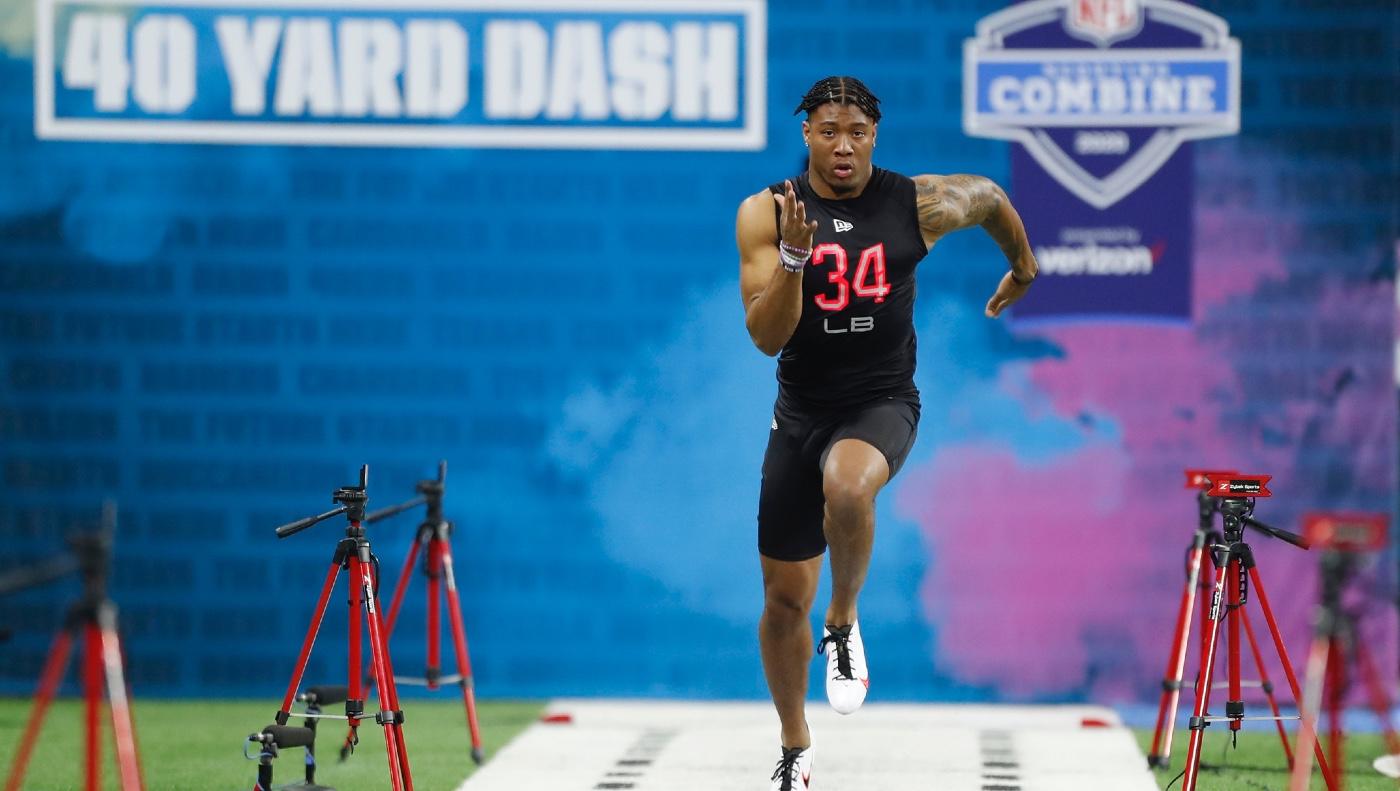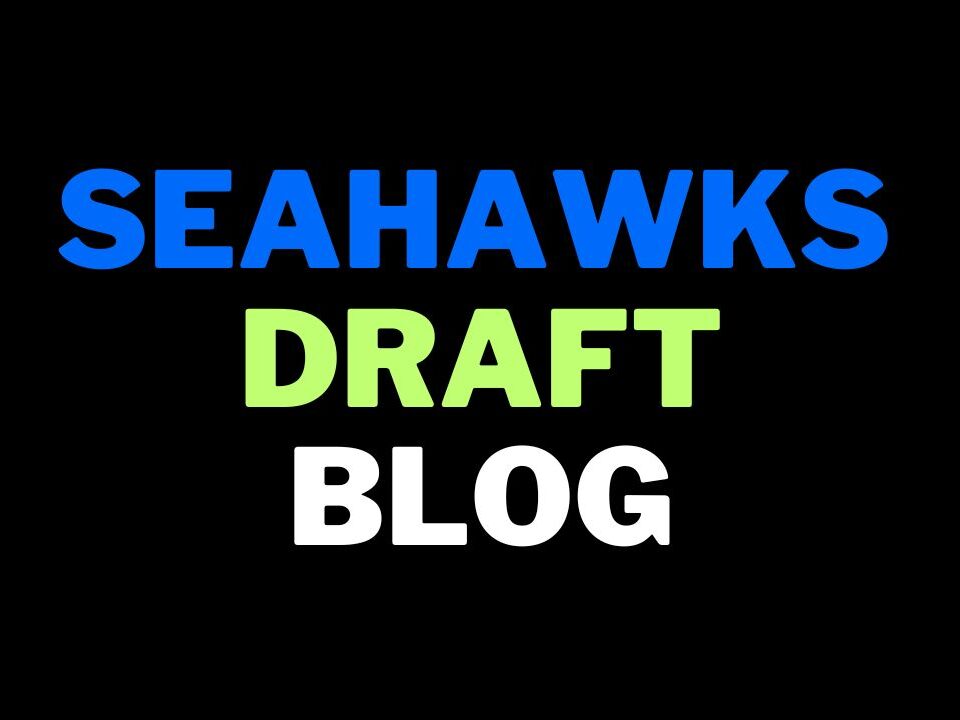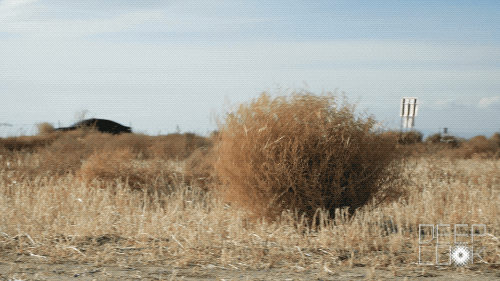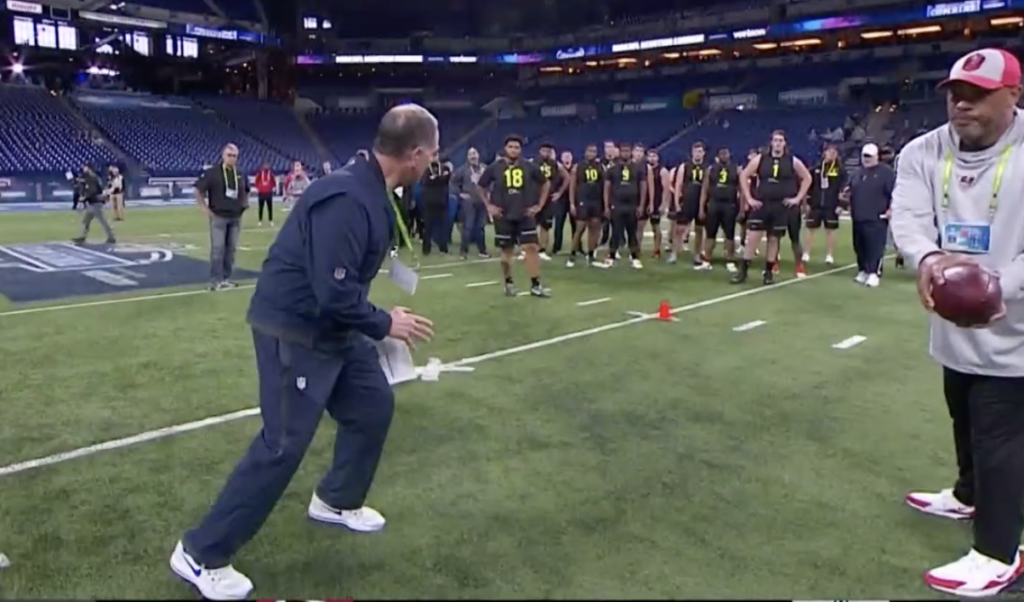
Isaiah Simmons was the star of the combine
What did we learn at this combine?
1. A significant number of top players are choosing not to do some or all of the drills. It’ll be interesting to see if this becomes a trend next year, particularly given the reportedly negative reaction to the switch to prime time. It’s time to pay the players for their time and effort to ensure this doesn’t become a second-tier event.
2. The defensive line and tight end groups are as thin as we feared. The Seahawks addressed their TE need by signing Greg Olsen. Their biggest issue is the pass rush though and we just witnessed the worst D-line workout at the combine in recent memory (more details here). No players ran an elite 1.5 10-yard split. There weren’t any obvious LEO candidates. It’s the least explosive group of defensive linemen we’ve seen in years. Unfortunately, it wasn’t unexpected.
3. There’s a significant collection of highly explosive and athletic offensive linemen destined to go in the top-20. Mekhi Becton, Tristan Wirfs, Austin Jackson and Jedrick Wills likely secured early grades. The question is whether or not Andrew Thomas, Isaiah Wilson and Ezra Cleveland have a shot to last to #27 if the Seahawks need a right tackle by April. The league is desperate for good offensive linemen.
4. There’s excellent depth at wide receiver and several first round prospects. The combine performance overall was underwhelming though. Henry Ruggs ran a 4.28 but that was expected. Many other big names — Jerry Jeudy, Ceedee Lamb, Jalen Reagor, Brandon Aiyuk — ran in the ‘good not great’ range. Tee Higgins didn’t do any drills because he said he fancied a rest. KJ Hamler was injured. It was a ho-hum display from a unit that promised much. The big exceptions are Denzel Mims (who leaves with his stock massively improved) and Chase Claypool.
5. There are some really good running backs in this draft but the well could run dry quickly. Jonathan Taylor’s workout brought back memories of Saquon Barkley in 2018. He could easily go in the top-20 as a consequence. D’Andre Swift and Clyde Edwards-Helaire didn’t do anything to diminish their stock. J.K. Dobbins sat out the combine. As much as the Seahawks need to add a runner, there are limited appealing options beyond the top-four based on their size preferences. Cam Akers is a name to watch though for the middle rounds.
6. Isaiah Simmons is that rare thing — a player worth trading up for. More on that in a moment.
7. This is not a Seahawks cornerback class. Only seven players met the +32 inch arm threshold. Three of the four didn’t do drills. One is 5-10 (and they generally stick to a strict 5-11 or taller rule). One is top-10 lock Jeff Okudah. They’re probably going to be looking elsewhere for some depth and competition here.
8. This isn’t a Seahawks linebacker class unless they have the opportunity and desire to consider Kenneth Murray or Patrick Queen in round one. The Seahawks value fast short shuttle times at the position but nobody got into the Cody Barton and Ben Burr-Kirven range from a year ago (4.1’s). They also like extreme athleticism. That could bring Willie Gay Jr into play — but they’ll check on his character flags first.
9. The safety class provides a nice mix of explosive traits and speed. Kyle Dugger ran a slower forty than expected (4.50) but should still go relatively early after jumping a 42 inch vertical and an 11-2 broad. Antoine Winfield Jr’s 4.46 — combined with his ability to fly to the ball and make plays (plus his bloodlines) will seriously interest teams. He looked outstanding during drills. Jeremy Chinn’s 4.46 forty, 41 inch vertical and 11-6 broad will grab attention. I thought Josh Metellus looked good too.
10. With so many players not working out for a variety of reasons, the pro-day circuit is going to be a lot more interesting this year.
Who looks like a ‘Seahawk’?
I’ve stuck to six realistic targets based on what we know about their physical preferences.
Hunter Bryant (TE, Washington)
All of the tight ends drafted during the Carroll era have run under a 7.10 three cone and have added a decent short shuttle time. Four players achieved that this year — Adam Trautman, Charlie Taumoepeau, Dalton Keene and Hunter Bryant (4.46ss, 7.08tc). I’ve focused on Bryant for a few reasons. Firstly, they traded for Jacob Hollister a year ago in a deliberate attempt to add a specific skillset. Bryant provides a dynamic mismatch target as a move-TE or big slot receiver. I think that’s something they want to feature. Secondly, we know the Seahawks like the way Washington trains its TE’s to block. Although it wasn’t his primary role, Bryant did a good job on tape when asked to block. Thirdly, he has the kind of character and attitude they like. If they want to add another target for Russell Wilson in this draft — Bryant could be a second round alternative if they miss out on the receivers early.
Jonathan Taylor (RB, Wisconsin)
We know the Seahawks have a type at running back. They have to be well sized, explosive and tough. Taylor is 5-10 and 226lbs (ideal for Seattle), he jumped a 36 inch vertical (ideal for Seattle) and he produced countless electric, physical big plays for Wisconsin — posting back-to-back 2000 yard seasons. Then he ran a 4.39 at the combine. He is exactly what they look for in a runner. He was interviewed by PFT during the week and he expressed his desire to play for Pete Carroll and with Russell Wilson in Seattle. The thing is — after this combine — he could be long gone by #27. He’s their type though and it wouldn’t be a surprise if he was a top player on their board.
Isaiah Wilson (T, Georgia)
Hulking size, run-blocking prowess and productive play in the SEC. That’s what the Seahawks have generally targeted when spending a high pick on a right tackle (James Carpenter, Germain Ifedi). Wilson is the next in line. He’s 6-6 and 350lbs with 35.5 inch arms, 10 1/4 inch hands and he’s nearly all muscle. In our weighted TEF formula, he finished second only to Tristan Wirfs as the best combination of size and explosive traits. He’s a formidable run-blocker and combined with Andrew Thomas — created never-ending time for Jake Fromm in the pocket. If he lasts to #27 it would be a major get for the Seahawks.
Jalen Reagor (WR, TCU)
You have to run a 4.4 to be an early pick at receiver for the Seahawks. Reagor’s 4.47 was slower than expected but he gained about 15lbs of muscle for the combine and it appeared to impact his speed and quickness. Even so, with the extra weight he still ran a 4.4. On tape he’s exactly what they look for in a receiver. He’s incredibly dynamic as a downfield threat who can win with easy separation for big chunk plays. He’s quick and sharp on shorter routes. Most impressively though — he’s highly explosive. He jumped a 42 inch vertical and it showed. Despite being only 5-11, he regularly out-jumped taller defensive backs to high-point the football and make catches in the red zone. Reagor also has some kick return spice. Overall he looks like a Seahawks-type receiver and could be a first round option.
Denzel Mims (WR, Baylor)
The Senior Bowl is a big event for the Seahawks. They’ve regularly tapped into the talent on show in Mobile. It’s how L.J. Collier piqued their interest a year ago. Tyler Lockett, Russell Wilson — both excelled in Mobile. This year Denzel Mims put on a show. He followed it up at the combine by running a 4.38 forty at 6-3 and 207lbs and jumping a 38.5 inch vertical. He’s adept at winning 1v1 on the outside either via contested catches or creating late separation on downfield shots. The Seahawks love to take chances downfield and that’s where Mims does his work. I have to say — I didn’t see a 4.38 runner on tape. It’s in the locker though and being able to line him up across from D.K. Metcalf with Tyler Lockett operating inside would give the Seahawks a lightning fast, highly threatening triple-threat receiving attack. He could be a first or second round target.
Hakeem Adeniji (G/T, Kansas)
For a number of years the Seahawks have sought explosive traits for the offensive line. Last year they took the second most explosive O-liner in the draft, Phil Haynes, in round four. They also like linemen with experience playing multiple positions. Adeniji played most of his college career at tackle but he has experience at guard and snapped in practise. He’s 6-4 and 302lbs with 34 inch arms. He was also the second most explosive lineman at the combine behind only Tristan Wirfs. Recently the Seahawks have signed veteran starters on the O-line and then drafted to develop with later picks. Adeniji could be an early day three target.
Kyle Dugger (S, Lenoir Rhyne)
As noted in our combine preview, the Seahawks don’t have a set profile for a safety. They’ve drafted fast players, slow players and everything in between. What they seem to really like is attitude and toughness. Dugger is an alpha male. He speaks with authority and he looks the part. He’s battled football adversity to get this far via Lenoir-Rhyne. He’s a hard hitter and a special teams demon. He jumped a 42 inch vertical and an 11-2 broad. A 4.50 forty is plenty for a man with his skill set. He could play linebacker or safety.
Other names to monitor include:
Justin Jefferson (WR, LSU) — he’s fast and reliable and has the kind of profile they target at receiver.
Cam Akers (RB, Florida State) — Akers is very explosive, well sized and looks the part of a potential C.J. Prosise replacement in the same kind of range (round three).
Cesar Ruiz (C, Michigan) — they love Michigan players and Ruiz is one of the best since Harbaugh took over with his explosive traits, size, quickness and pure talent.
Jeremy Chinn (S, Southern Illinois) — he’s been compared to Kam Chancellor. I didn’t see that on tape but he had a terrific workout — running a 4.46 and jumping a 41 inch vertical.
Nick Harris (C, Washington) — he’s Joey Hunt plus and if they were willing to draft and start Hunt, they might be willing to consider Harris in the middle rounds considering he represents the grit and physicality they desire.
Brandon Aiyuk (WR, Arizona State) — he just screams Seahawks on tape. He does everything they like and he’s a return threat on special teams. He ran a 4.50 but who’s to say he didn’t crack the 4.4’s on a Seattle scouts’ hand-time stopwatch? I doubt they need an excuse to grab him.
Matt Peart (T, Connecticut) — He was the eighth most explosive tester among offensive linemen and he has outrageous size (6-7, 318lbs, 36 5/8 inch arms). He’s a ball of clay ready to be moulded and that’s what they seem to be drafting for the O-line these days.
Raekwon Davis (DT, Alabama) — They’ve been looking for a Calais Campbell type for years. As noted yesterday, Davis’ physical profile is very similar.
Combine winners at each position
This is based on drills and testing…
Quarterback — Jalen Hurts
Running back — Jonathan Taylor
Tight end — Adam Trautman, Hunter Bryant, Charlie Taumoepeau, Dalton Keene
Wide receiver — Denzel Mims, Chase Claypool
Offensive tackle — Mekhi Becton, Tristan Wirfs, Austin Jackson, Ezra Cleveland, Jedrick Wills, Isaiah Wilson, Matt Peart
Interior O-line — Cesar Ruiz, John Simpson, Hakeem Adeniji, Damien Lewis, Nick Harris, Matt Hennessy
Defensive tackle — Justin Madubuike
Defensive end — Jabari Zuniga
Linebacker — Isaiah Simmons, Willie Gay Jr
Cornerback — Jeff Okudah, CJ Henderson
Safety — Antoine Winfield Jr, Josh Metellus, Jeremy Chinn, Kyle Dugger
Where do the Seahawks go from here?
For once there’s a trade-up scenario that makes sense
Every year I’m asked if there’s anyone the Seahawks should consider moving up for and I always say no.
Not this year.
Isaiah Simmons is worth trading up for.
There’s little chance of it happening, of course. The stars would have to align in so many different ways. That doesn’t mean it shouldn’t be discussed.
In 2011, the Atlanta Falcons moved up from #27 to #6 to select Julio Jones. The trade cost the Falcons their second round pick (#59), a fourth round pick (#124) and their 2012 first rounder.
It was a bold gamble, just like any trade. It’s easy to sit here with hindsight and praise the decision. There are countless other trades where the gamble didn’t pay off.
Yet Jones’ extreme physical profile, character and college production at least tipped the balance in Atlanta’s favour.
We’ve arguably not seen a player like Jones since 2011… until this weekend.
Julio Jones
Height: 6-2 3/4
Weight: 220lbs
Forty: 4.42
Vertical: 38.5 inches
Broad: 11-3
Isaiah Simmons
Height: 6-3 5/8
Weight: 238lbs
Forty: 4.39
Vertical: 39 inches
Broad: 11-0
Simmons ticks all of the boxes. He has a tremendous athletic profile. In 2019 he registered 102 tackles, 16 TFL’s, eight sacks, three interceptions and nine PBU’s. He’s a natural leader and was a heart and soul type for Clemson’s Championship team.
This is exactly the type of player you roll the dice on.
Imagine what he’d be like for the Seahawks too. He could easily line up in the Mychal Kendricks role to offer both coverage ability and some pressure/pass rush. He could be a long term replacement for K.J. Wright at WILL. He could be Kam Chancellor with less intimidation but a lot more speed.
You could pretty much ask him to do anything — because he showed at Clemson he can do everything.
If it was possible — and let’s be realistic, it probably isn’t — to pull off a deal similar to the Julio trade, it’d be worth considering. It’s a coincidence that the Seahawks own the same picks that Atlanta had in 2011.
When discussing a trade like this you need to suggest a partner. It’d need to be a team at the start of a rebuild that is valuing picks over draft order.
The only obvious candidate is Carolina at #7. They have a new coach and a fresh start. They’ve moved on from Greg Olsen, Luke Kuechly has retired and I’m not sure anyone is really convinced by their lukewarm support of Cam Newton last week.
Let’s say they were targeting Jordan Love as a late first round pick and felt he would be there in the 20’s as their quarterback of the future. They might be tempted to move down, get their guy and collect a haul of picks.
This would also require Simmons to last to pick #7 of course (although Julio Jones did last to #6 in 2011). If we assume the Bengals select Joe Burrow and the Redskins Chase Young, you’d probably need the following to happen:
#3 Detroit trade with the Chargers for a quarterback
#4 The Giants stick to the trenches (OL or DL) under Dave Gettleman
#5 The Dolphins select a quarterback
#6 Having traded down, the Lions select Jeff Okudah
I appreciate how far fetched and dreamy all of this is. I’m simply proposing a talking point. Simmons could easily be snapped up with the third pick by Detroit after the way he performed in Indianapolis.
Seattle’s defense desperately needs a shot in the arm though. It needs a significant injection of talent — via free agency and the draft.
Isaiah Simmons is the ideal modern defender. He has the freakish physical profile Seattle loves. He has the character. He has the proven production. He has star power.
If there was ever a time to move up in the draft, it’d be for him. And regulars know I’m not the type to talk in that way about trading up.
The Seahawks’ task in free agency just got harder
The clear off-season priority was to fix the flailing pass rush. They finished the 2019 season with 28 sacks, second fewest in the league behind only Miami (23). Their sack percentage was 4.5% — third worst overall.
They had only 126 pressures, sixth fewest in the league. Seattle’s pressure percentage was the fourth worst (19.3%) behind Detroit (18.9%), Houston (18.1%) and Miami (16.7%). They hit the quarterback 68 times — fourth fewest. They had 52 TFL’s — again, fourth fewest.
You might not need an elite, LOB style defense to win a Championship — but you can’t be this bad at creating pressure.
Unfortunately, as noted on Saturday, this is the worst D-line draft class in recent memory. Yes — several names opted not to perform at the combine. Those who did test, however, made it very clear. There’s no speed. No quick twitch. No LEO.
This creates two big problems:
1. The rest of the NFL watched San Francisco make the Super Bowl guided by a dynamic four-man rush. Many teams are going to try and emulate that. That means competing in free agency for the best pass rushers.
2. Several prospective free agent pass rushers are going to be tagged now, because the league knows cheap replacements are not forthcoming. This will thin out the free agent class and make players like Jadeveon Clowney a prized asset.
A difficult situation usually means an aggressive approach
The Seahawks don’t do things by half. When they’ve got a problem to solve, they go after it.
When they didn’t like the look of the 2013 draft options they gave Minnesota their first round pick for Percy Harvin. Two years later they didn’t see a dynamic red-zone target in the draft, so they traded a first round pick for Jimmy Graham.
In 2017 they were forced to replace Malik McDowell with an expensive rental for Sheldon Richardson. In the same year, they had to replace the injured George Fant with Duane Brown — a deal that cost two more high picks.
When they were in desperate need for pass rushers last year after trading Frank Clark, they boldly acquired Clowney and Ziggy Ansah and spent a first round pick on L.J. Collier.
Now the Seahawks are facing a similar dilemma. They can’t go into next season with the same problems on defense. If free agency is too expensive and the draft a dead duck for the D-line, it could mean more trades.
We’ve seen a developing trend of pass rushers being traded on the franchise tag. A year ago, Clowney, Frank Clark and Dee Ford were dealt. The Seahawks could look at trying to fix a deal with Kansas City for Chris Jones or Jacksonville for Yanick Ngakoue. However — both would require serious compensation and a new contract.
Furthermore, you’d be forced to offer the going rate for a top pass rusher. If you pass on paying Clowney in free agency, you’d only be faced with having to pay the same amount (or more) to someone like Jones or Ngakoue, albeit with picks thrown into the mix too.
There’s also the veteran market.
It’s unclear what that will be like. Von Miller voiced some displeasure in Denver’s direction at the end of last season but there’s been no trade rumours since. Although, I suppose, the Harvin and Graham trades caught everyone off guard.
A deal for Miller would be ideal — providing the Seahawks with the kind of premier EDGE Pete Carroll has identified as an absolute requirement. It’d cost at least the #27 pick though, if not more. And that’s if Denver is even willing to entertain the move.
It appears the Redskins are set to hold onto Ryan Kerrigan. Jacksonville are worth a call for Calais Campbell — but they’d be mad to actually make a deal.
The realistic (and affordable) trades all appear to be at other positions. Andy Dalton at the Bengals, Darius Slay at the Lions and Trent Williams at the Redskins.
If they’re going to make a deal — it might end up being out of left field. Keep an eye on rebuilding teams and clubs who haven’t got a lot of cap space.
What might they do?
1. Spend their resources on the defensive line (they have to)
2. Consider trading #27 for a premier pass rusher
3. Bring in a cheaper veteran right tackle as a draft hedge (Williams? Veldheer?)
4. Add a weapon for Russell Wilson relatively early in the draft — either a receiver or Hunter Bryant
5. Put themselves in a position to draft ‘their guys’ rather than needing to aggressively fill needs
You can now support Seahawks Draft Blog via Patreon by clicking the tab below.
Become a Patron!











